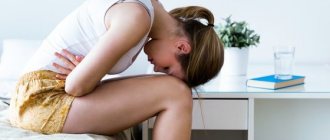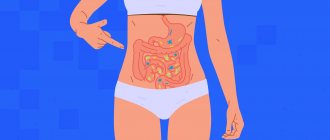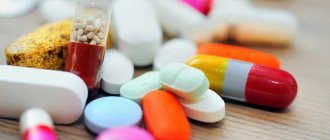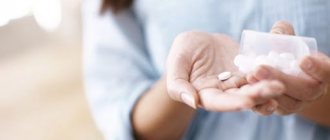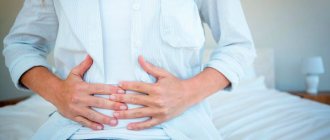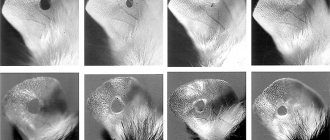Antibiotics are the greatest invention of mankind. They have saved and continue to save thousands of lives every day and hour. But these drugs destroy both pathogenic microorganisms and beneficial inhabitants of our body. It is important to understand that doctors usually prescribe broad-spectrum antibiotics that act on most pathogens.
Narrowly targeted drugs are used only in exceptional cases, and they also destroy beneficial flora. As a result, we treat the underlying disease, but cripple other organs and systems. Quite often a phenomenon called dysbacteriosis occurs. What treatment is necessary for dysbiosis after antibiotics?
How does taking antibacterial drugs affect the vaginal microflora?
To understand the connection between taking these medications and the state of the vaginal microflora, you first need to understand what antibacterial drugs are and what their main function is.
While destroying harmful bacteria, antibiotics also destroy beneficial ones, disrupting the normal flora of both the intestines and vagina. Taking antibiotics leads to a significant decrease in the number of lactobacilli (Doderlein bacilli) (Lactobacillus), which are part of the total vaginal microflora and are its basis. They provide an acidic environment in the vagina (pH = 3.8-4.5), which prevents dangerous infections from entering the vagina, uterus and appendages. When the number of lactobacilli decreases, the pH level increases to 4.5 and higher, resulting in the creation of conditions for the development of vaginal dysbiosis (dysbiosis). This condition is a common consequence of disruption of the vaginal microflora after taking antibiotics.
Taking antibiotics, vaginal microflora
Dysbacteriosis often leads to the development of candidiasis (thrush), and can also cause the development of diseases such as colpitis, cystitis, cervicitis, adnexitis (also known as salpingoophoritis), etc.
Dysbiosis can be asymptomatic or be represented by the following symptoms:
- Itching and burning in the vagina.
- Unusual vaginal discharge that differs from normal in smell, color and consistency.
- Redness and swelling of the vaginal walls.
- Pain when urinating and during intimacy.
Diagnosis, treatment
There are no specific individual symptoms of intestinal microflora imbalance. This is a whole complex of symptoms, but in each patient these processes can occur differently. Symptoms of intestinal dysbiosis:
- Belching and nausea
- Vomiting and diarrhea
- Unpleasant taste in the mouth
- Halitosis
- Epigastric pain
- Allergic reactions to seemingly safe products
- Possible low temperature
The symptoms of this pathology are similar to the signs of various diseases of the gastrointestinal tract and viral ailments. Therefore, often the symptoms of imbalance are either ignored or completely different, often non-existent diseases are treated. Diagnosis of dysbiosis is the process of identifying disturbances in the microflora of the stomach and intestines. There are 2 methods for determining the degree of imbalance:
- Bacterial culture for flora - most often you will have to donate stool. In the laboratory, from 14 to 25 types of microorganisms populating the human intestine are determined. The duration of analysis processing ranges from 5 to 7 days, depending on the equipment of the laboratory. It depends on how much bacteria grow in the nutrient medium. When pathogenic organisms are detected on an alarming scale, the laboratory conducts sensitivity tests to antibacterial agents.
- Study of substances that microorganisms release during their activity. The advantage of this method is speed - the results are ready within a few hours.
Treatment of dysbiosis after antibiotic therapy is as follows:
- Diet
- Lifestyle change
- Specific therapy to neutralize the pathogen
- Restoration of microflora with special preparations
- Increasing local immunity
- Treatment is selected by the attending physician according to test data.
How to restore vaginal microflora after antibiotics?
If you observe symptoms of vaginal dysbiosis, be sure to consult a specialist. The doctor will conduct an examination on the chair and take a smear sample for examination in the laboratory (usually for this purpose the method of bacteriological culture for microflora and sensitivity to antibiotics, or, in common parlance, bacterial culture is used). If the cause of unpleasant symptoms is indeed a violation of the composition of the microflora, the gynecologist will prescribe appropriate treatment. Therapy for vaginal microflora dysbiosis should solve the following problems:
- Suppression of pathogenic microorganisms.
- Creation of optimal conditions for the growth of normal microflora with its subsequent colonization.
- Increasing immunity and maintaining flora balance in the future.
Gynecologists are involved in solving these problems, helping to select means to accelerate the restoration of microflora after antibiotics and prevent more serious disorders.
Expert opinion
It is important to completely restore the disturbed microflora, since dysbiosis that is not fully cured can recur in the future.
Obstetrician-gynecologist of the highest category Oksana Anatolyevna Gartleb
Dysbacteriosis: general information
Antibiotics kill not only pathogenic flora
Dysbacteriosis is a violation of the ratio of the quantity and composition of microflora in the body. Our body is not sterile, and many processes occur with the participation of various microorganisms. Not all of them are beneficial; some can cause various diseases. But as long as the quantities of both are in a certain balance, the body feels good.
Antibiotics kill everyone. There is no protection and surviving pathogens - fungi, bacteria, other microorganisms - begin to colonize the mucous membranes of the intestines, stomach, oral cavity, genitals, nails and eyes. Dysbacteriosis is not considered an independent disease. This is a consequence of the illness and treatment. The most common variations of bacterial imbalance are:
- Intestinal dysbiosis
- Dysbacteriosis of the oral cavity
- Dysbacteriosis of the genital area - gardnerellosis, candidiasis, E. coli
- Each has its own methods of diagnosis, treatment and preventive measures.
Preparations for normalizing microflora after antibiotics
First you need to determine the causative agent of dysbiosis. Therapy for vaginal microflora disorders depends on the degree of intensity of the symptoms of dysbiosis. This may involve both taking pills and using topical medications (sometimes both approaches can be used together).
Vaginal suppositories to restore intimate microflora
Suppositories for restoring microflora after antibiotics
To eliminate dysbiosis, vaginal suppositories (suppositories) are widely used. These are bullet-shaped solid preparations with a fat base, which, after insertion into the vagina, melt under the influence of body temperature. This allows the active components of suppositories to quickly penetrate the vaginal mucosa and destroy harmful microorganisms.
To combat pathogenic agents and restore flora in women, suppositories based on metronidazole, miconazole, nystatin, bifidobacteria, lactobacilli acidophilus, etc. are used.
Intestinal dysbiosis in adults
Dysbacteriosis can develop in 4 stages.
Dysbiosis (dysbacteriosis) of the intestine is a special state of its microflora, characterized by a qualitative and (or) quantitative imbalance between beneficial and pathogenic bacteria. There are four stages of development of dysbiosis:
- The first is characterized by asymptomatic manifestation. The only thing is that the color of the stool may change. Treatment consists of restoring the balance between harmful and beneficial bacteria using medications;
- The second stage is characterized by: loss of appetite, nausea, pain in the stomach, upset stool (diarrhea, constipation), allergic skin rashes;
- At the third stage, symptoms worsen: diarrhea becomes chronic, the patient’s stool contains mucus and undigested pieces of food, constipation, flatulence, intestinal pain;
- The fourth - advanced stage of dysbiosis is characterized by serious disturbances in the normal functioning of the gastrointestinal tract: lack of appetite, chronic diarrhea (blood may be present in the stool), nausea. In addition, there is a deterioration in the general condition: weakness, decreased performance, headaches. A particular danger to the body is intoxication and damage to internal organs (when toxins enter the blood).
Early diagnosis and treatment ensure the likelihood of a full recovery without consequences for the body.
If symptoms of dysbiosis are detected, you should not self-medicate, since the main task is to identify the cause of this disorder. The gastroenterologist will prescribe tests (coprogram, microscopic examination of stool, culture for dysbacteriosis, etc.) and, taking into account the results obtained, will prescribe medication:
- Preparations to combat pathogens (furazolidone, streptomycin, chloramphenicol, enterosedive, intetrix, specific bacteriophages, toxoids with antibiotics, etc.);
- Antispasmodics to eliminate pain symptoms;
- Laxatives and antidiarrheals;
- Enterosorbents (to remove toxins) and enzymes (to ease the load on the stomach);
- Immunostimulants and vitamins;
- Antiallergens;
- Prebiotics and probiotics;
- The mandatory course of treatment for dysbiosis includes diet. It is developed taking into account the receipt of a balanced diet, excluding heavy, difficult-to-digest foods. It is recommended to consume natural probiotics (yogurt, kefir, cheese, sauerkraut, yeast-free bread, acidophilus milk) and prebiotics (banana, asparagus, onion, garlic, Jerusalem artichoke, wheat bran, flour, chicory root, strawberries);
- An effective method of treating dysbiosis is physiotherapy: liver electrophoresis, intake of sodium-calcium and bicarbonate-chloride waters, colon hydrotherapy, etc.
Prevention of dysbiosis in adults includes the following measures: a ban on smoking and alcohol, a balanced and nutritious diet, and when treated with antibiotics, taking medications containing lactobacilli.
Vaginal tablets for vaginal microflora
The principle of action of vaginal tablets for restoring vaginal microflora is similar to the action of suppositories. The difference is that after inserting suppositories into the vagina, the remainder of their fat base may leak and stain underwear, so they are usually installed at night. After using vaginal tablets, there is usually no such problem. The active ingredients of vaginal tablets and suppositories are most often identical.
Microflora disorders
Causes of intestinal microflora disorders
A healthy person has about 500 species of bacteria in their intestines.
Beneficial bacteria digest food, enrich the body with nutrients, and support the immune system. These bacteria constantly work and regulate intestinal function, maintain ionic balance, neutralize various toxins, break down proteins, carbohydrates, and even synthesize some vitamins. Along with beneficial bacteria in the intestines live pathogenic bacteria, which are waiting for the right moment to remind themselves. They can be activated by weakened immunity, frequent stress, poor diet, or exacerbations of gastrointestinal diseases.
Disruption of intestinal microflora can reduce the absorption of nutrients in the intestines and thus disrupt the digestion process. Leftover undigested food leads to rumbling, bloating, diarrhea and other symptoms.
The main causes of intestinal microflora disturbances include:
- Uncontrolled use of medications, for example, antibiotics, which affect both pathogenic and “beneficial” intestinal bacteria;
- Improper diet, containing monotonous food that does not contain all the nutrients a person needs;
- Impaired intestinal motility;
- Uncontrolled dieting;
- Intestinal infections;
- Chronic diseases of the gastrointestinal tract (gastritis, enteritis, colitis, etc.);
- Endocrine diseases;
- Stress and depression;
- Alcohol abuse, smoking.
Disturbance of the intestinal microflora manifests itself in the form of dyspepsia associated with disruption of the gastrointestinal tract. This condition leads to bloating, alternating constipation and diarrhea, abdominal pain, etc. With dysbacteriosis, unexpected allergic reactions to certain foods may develop, accompanied by nausea, vomiting, diarrhea, itchy skin, and rash. In some cases, when the microflora is disturbed, the absorption of nutrients is disrupted, a deficiency of iron, vitamins, etc. develops, and immunity decreases. The patient may complain of weakness, headaches, and lack of appetite.
Restoring vaginal flora using creams and gels
To normalize the balance of vaginal flora, the use of creams and gels is often prescribed. These topical products are water-based, which helps them absorb quickly without leaving behind a sticky or greasy film.
Restoring gel “Ginocomfort” is one of these products that helps normalize the balance of mixed vaginal microflora. Its advantage is the applicator included in the kit, which allows you to insert the gel intravaginally, which prevents it from leaking. This product contains lactic acid, which helps maintain the acidity level of the vagina at a physiological level, as well as tea tree oil, an effective natural antiseptic that has antimicrobial and anti-inflammatory effects. In addition, the gel contains chamomile extract, panthenol and bisabolol - active components that help relieve inflammation and irritation, accelerate regeneration and maintain the tone of the vaginal walls.
Restoration of vaginal microflora after antibiotics
Prevention of imbalance of vaginal microflora
To avoid further imbalance of vaginal flora, follow preventive measures. The most important among them are the following:
- The course of treatment with antibiotic drugs should not be long and take into account the sensitivity of the pathogenic microorganism - discuss with the doctor the duration of the course of their use at the time of treatment, report previous cases of absence of normal microflora and let the doctor independently prescribe additional means to protect it. You also need to remember that these medications are completely ineffective against viruses, so taking them during a flu epidemic “just in case” (as some women sometimes do) is absolutely pointless and dangerous.
- Strengthen the immune system, since vaginal dysbiosis manifests itself as a result of a decrease in the body’s defenses. For this (especially in the autumn-winter period and early spring), a balanced diet of foods is recommended: eat enough fresh fruits and vegetables, fiber, healthy fats, onions and garlic. At the same time, it is necessary to reduce the consumption of sweets, beer and yeast baked goods, since sugar and yeast contribute to disruption of the nutrition of the vaginal microflora. Also, to increase the body's defenses, hardening, taking a contrast shower, and increasing emotional stability in stressful situations are recommended.
- Pay attention to intimate hygiene. To maintain an optimal balance of vaginal flora, it is necessary to wash yourself using special products designed specifically for this area, since simple soap has an alkaline pH and disrupts the natural acidic balance of the microflora of the intimate area. The Ginocomfort washing gel is suitable for daily hygiene - it gently cleanses the intimate area and maintains the acidity level of the vagina at the desired level, thanks to the presence of lactic acid and sodium lactate in the gel. The product also contains tea tree oil, bisabolol, chamomile extract and panthenol - these components are involved in eliminating vaginal itching and dryness, have an antibacterial effect and improve skin regeneration. Clinical studies have shown that the product does not cause allergic reactions and is well tolerated by women. The product is certified and has all the necessary documents confirming the safety of its use.
- Timely undergo a preventive examination for a test with a smear taken for flora for laboratory research (it is advisable to do this at least once every 6 months). Vaginal dysbiosis is often asymptomatic and a woman can only find out about it at a scheduled appointment with a gynecologist.
- If possible, avoid stressful situations, maintain a balanced work and rest schedule, and have a healthy, regular sex life. It is worth noting that the sperm of a healthy man has an extremely positive effect on the vaginal microflora.
Expert opinion
Compliance with preventive measures and timely treatment of vaginal dysbiosis caused by taking antibacterial agents will help maintain the balance of vaginal microflora and maintain your health.
Obstetrician-gynecologist of the highest category Oksana Anatolyevna Gartleb
Vaginal microflora after taking antibiotics
Sources:
- VAGINAL DYSBIOSIS: MODERN ASPECTS OF DIAGNOSIS AND TREATMENT. Voronova Yu.V. // Far Eastern Medical Journal. – 2014. – P. 35-40.
- MODERN VIEWS ABOUT THE MECHANISMS OF DEVELOPMENT OF VAGINAL DYSBIOSIS. Dobrokhotova Yu.E., Zatikyan N.G. // Obstetrics, gynecology and reproduction. – 2008. – No. 1. – P. 7-9.
- BACTERIAL VAGINOSIS IN WOMEN SUFFERING WITH NON-SPECIFIC ULCERATIVE COLITIS. A.Z. Mullagalina // Bulletin of the Russian Peoples' Friendship University. – 2011. – P. 213-219.
- The effectiveness of restoring the vaginal biocenosis of women with polycystic ovary syndrome in the treatment of cervical pseudo-erosion. Kalinkina O.B. // Materials of the International Scientific and Practical Conference “Prevention of Cervical Cancer: A Look into the Future.” – M. – 2008. – P. 62-63.
- Correction of vaginal dysbiosis in women with a history of miscarriage. Pluzhnikova T.A. // Russian Bulletin of Obstetrician-Gynecologist. – 2008. – No. 3. – P. 74-76.
- Step-by-step treatment of pathological processes of the reproductive organs associated with urogenital infections. Kulaga O.K. // Obstetrics and gynecology. – 2008. – No. 6. – P. 54-56.
- https://www.pnas.org/content/108/Supplement_1/4680
- https://www.hindawi.com/journals/idog/2005/607474/abs/
- https://journals.plos.org/plosone/article?id=10.1371/journal.pone.0105998
- https://bmcmicrobiol.biomedcentral.com/track/pdf/10.1186/1471-2180-9-116
Diet for dysbiosis
Treatment of pathology should begin with dietary correction. Sometimes this is enough to defeat dysbiosis and other concomitant diseases, and work on your figure. Products that are prohibited:
- Spicy and fatty foods. It irritates the intestinal mucous membranes, and this leads to the death of beneficial microorganisms. The pathogenic flora feels good at this time. Digestive processes begin to slow down, constipation occurs and dysbiosis intensifies.
- Baked goods, sauerkraut, fermentable foods.
- Meat only boiled or baked. Roasts and steaks are prohibited.
- Sweets, strong coffee, alcohol in any form, condensed milk.
- Canned or pickled foods.
- Spicy seasonings - horseradish, mustard, pepper - are not for you.
Food should be natural. If possible, avoid products with preservatives, artificial colors, and various flavorings.
Dysbacteriosis is fraught with serious complications
After eating, walk for 30 minutes and only then drink tea or compote. Liquid reduces the concentration of gastric juice, and this has a bad effect on the processes of food digestion. What to pamper yourself with dysbiosis:
- Products containing bifidobacteria and lactobacilli. Kefir, sour cream, fermented baked milk, natural yoghurt should be present in the diet daily. If possible, it is better to buy ready-made starter cultures and make homemade live kefir and yoghurt.
- Plant fiber stimulates digestion. Vegetables, cereals, fruits - daily. Any greens - basil, cilantro, parsley - should always be on the table. Baked or mashed potatoes without oil.
- Porridge – buckwheat, oatmeal. Semolina and rice should be limited, as they can lead to bowel movements.
- Soups with low-fat broth - chicken or turkey, veal or lean pork.
- Applesauce is recommended for the treatment of dysbiosis. Prepared from baked or stewed apples. This dish is a kind of plant probiotic.
A diet for dysbacteriosis is not a diet in the direct sense. It's more of a healthy diet. It's easy to stick to.
Popular questions
If a woman’s microflora is disturbed, then should her partner take pills and which ones?
If dysbacteriosis is detected in a woman, treatment and examination of her partner is mandatory. Therapy is determined by the results of the examination and prescribed by a urologist.
She took tests for microflora and cytology. After which, as usual, it was a little painful to go to the toilet, for about 1 day. Then it passed, on the trail. One day there was protected sexual intercourse, and a day later menstruation began, a burning sensation and itching appeared. It hurts to go to the toilet, there is no discharge or blood. And this has been going on for a week now. The test results are good. There were no complaints before these tests.
Have you noticed dryness during sexual intercourse or some trauma to the mucous membranes of the genital tract, which could worsen during menstruation? I recommend using Gynocomfort gel with tea tree oil, which will allow for mild anti-inflammatory therapy, heal microtraumas of the mucous membranes and balance the lactoflora in the genital tract. The gel is used in 1 dose 1 time per day for 7-10 days.
After taking antibiotics, thrush appeared, white discharge in the perineum, can I use clotrimazole cream or solution, which is better? Candles cannot be used in my case. Thank you
Hello! I recommend that you see an obstetrician-gynecologist and have an examination - a smear on the flora of these secretions. This will help to pinpoint the cause. At this stage, you can use Gynocomfort gel with tea tree oil. This remedy will have an anti-inflammatory effect, relieve itching and irritation. The gel is applied once a day for a week.
Hello. After taking antibiotics for a long time, there is a burning sensation in the intimate area, tell me if Ovestin suppositories will help, if not, recommend your remedy?
Hello!
To relieve itching after using antibiotics, it is better to use Gynocomfort gel with tea tree oil. This remedy not only has a nonspecific anti-inflammatory effect, relieving swelling and irritation, but also stabilizes the pH environment in the genital tract due to the content of lactic acid, replenishing the deficiency of lactobacilli. For an accurate diagnosis, contact a specialist
